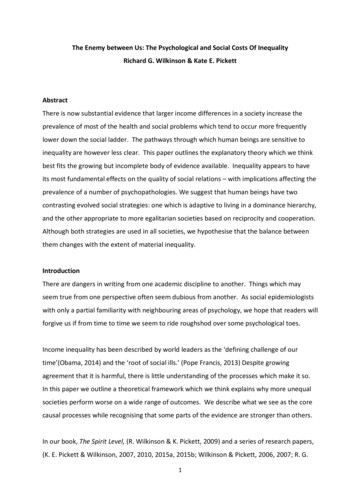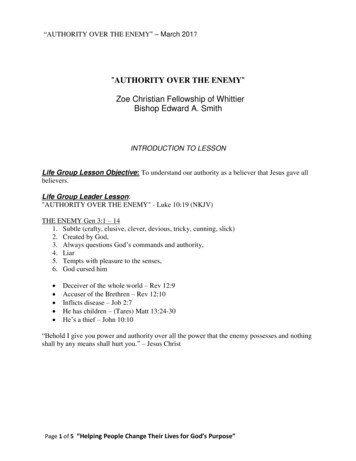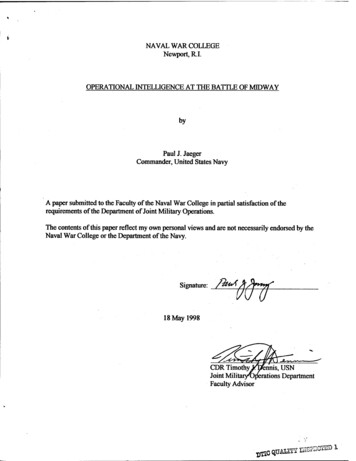
Transcription
The Enemy between Us: The Psychological and Social Costs Of InequalityRichard G. Wilkinson & Kate E. PickettAbstractThere is now substantial evidence that larger income differences in a society increase theprevalence of most of the health and social problems which tend to occur more frequentlylower down the social ladder. The pathways through which human beings are sensitive toinequality are however less clear. This paper outlines the explanatory theory which we thinkbest fits the growing but incomplete body of evidence available. Inequality appears to haveits most fundamental effects on the quality of social relations – with implications affecting theprevalence of a number of psychopathologies. We suggest that human beings have twocontrasting evolved social strategies: one which is adaptive to living in a dominance hierarchy,and the other appropriate to more egalitarian societies based on reciprocity and cooperation.Although both strategies are used in all societies, we hypothesise that the balance betweenthem changes with the extent of material inequality.IntroductionThere are dangers in writing from one academic discipline to another. Things which mayseem true from one perspective often seem dubious from another. As social epidemiologistswith only a partial familiarity with neighbouring areas of psychology, we hope that readers willforgive us if from time to time we seem to ride roughshod over some psychological toes.Income inequality has been described by world leaders as the ‘defining challenge of ourtime’(Obama, 2014) and the ‘root of social ills.’ (Pope Francis, 2013) Despite growingagreement that it is harmful, there is little understanding of the processes which make it so.In this paper we outline a theoretical framework which we think explains why more unequalsocieties perform worse on a wide range of outcomes. We describe what we see as the corecausal processes while recognising that some parts of the evidence are stronger than others.In our book, The Spirit Level, (R. Wilkinson & K. Pickett, 2009) and a series of research papers,(K. E. Pickett & Wilkinson, 2007, 2010, 2015a, 2015b; Wilkinson & Pickett, 2006, 2007; R. G.1
Wilkinson & K. E. Pickett, 2009) we have discussed the work of many scholars showing that along list of health and social problems with social gradients, i.e., problems that are morecommon further down the social ladder, are much more prevalent in societies with largerincome differences between rich and poor (Figure 1).Health outcomes related to income inequality include longer life expectancy and highermortality rates, including infant mortality. (Babones, 2008; De Vogli, Mistry, Gnesotto, &Cornia, 2005; Hales, Howden-Chapman, Salmond, Woodward, & Mackenbach, 1999; Kondo etal., 2009; Ram, 2006; Subramanian & Kawachi, 2004; Wilkinson & Pickett, 2006, 2007) Ratesof mental illness and obesity are two to four times higher in more unequal societies. (Offer,Pechey, & Ulijaszek, 2012; K. E. Pickett, Kelly, Brunner, Lobstein, & Wilkinson, 2005; K. E.Pickett & Wilkinson, 2010) In both developing and developed countries HIV infectionprevalence rises with inequality. (Drain, Smith, Hughes, Halperin, & Holmes, 2004; Over, 1998)The research literature on income inequality and health is extensive; in 2015, we reviewedthis literature within a causal framework of Popperian theory testing (Popper, 2014) andepidemiological causal criteria, and found it strongly supportive of a causal explanation. (K. E.Pickett & Wilkinson, 2015c)Indicators of social cohesion, including generalised trust and social capital are also better inmore equal countries. (Elgar, 2010; Elgar & Aitken, 2011; Kawachi, Kennedy, Lochner, &Prothrow-Stith, 1997; Rothstein & Uslaner, 2005; E. Uslaner, 2002) Indicators of women’sstatus and equality are generally better, (Kawachi, Kennedy, Gupta, & Prothrow-Stith, 1999; R.Wilkinson & K. Pickett, 2009) and a large literature shows that rates of both property crimeand homicides increase as income differences widen. (Daly, Wilson, & Vasdev, 2001; Elgar &Aitken, 2011; F. J. Elgar et al., 2013; Fajnzylber, Lederman, & Loayza, 2002; Hsieh & Pugh,1993; Krahn, Hartnagel, & Gartrell, 1986; Rufrancos, Power, Pickett, & Wilkinson, 2013)Children’s life chances and trajectories are also affected by income inequality. The UNICEFIndex of Child Wellbeing in rich countries has been shown repeatedly to be significantly higherin more equal societies. (K. E. Pickett & Wilkinson, 2007, 2015a; Unicef, 2016) Educationalattainment is higher, fewer young people drop out of education, and fewer teenage girlsbecome mothers in more equal societies. (K. Pickett & Vanderbloemen, 2015; Siddiqi, Kawachi,2
Berkman, Subramanian, & Hertzman, 2007; Wilkinson & Pickett, 2007) Equality of opportunityis damaged by inequality of outcomes – social mobility is restricted in very unequal societies.(Blanden, 2009; Wilkinson & Pickett, 2007)Although the effects of inequality tend to be greatest among the poorest in each society,outcomes tend to be less good even among the better off. Indeed, it is because a largemajority of the population – not just the poor – are affected by inequality that the differencesin the performance of more and less equal societies are so large. The scale of the differencesvaries from one health or social problem to another, but they are all between twice and tentimes as common in more unequal societies compared to more equal ones.Figure 1: Health and social problems are closely related to inequality among rich countries.(R. Wilkinson & K. Pickett, 2009)The evolved psychology of social relationsOur own work on the social effects of income inequality came out of research on healthinequalities. From that initial biological background it came to focus particularly on causal3
processes centred on the sources and effects of chronic stress. The explanatory picture weshall outline is made up like a jigsaw puzzle from pieces contributed by research workers in avariety of different fields. At its centre is an evolved psychology of social relations which leadspeople to use different social strategies in more and less hierarchical contexts.Robin Dunbar’s work on the close correlation between the proportion of the brain made up ofthe neocortex and the typical group size in primate species is a powerful indication that thecomplexities of social relations have been crucial to human brain development. Since Dunbarfirst formulated this ‘social brain hypothesis’, further research has confirmed that non-humanprimate species with larger group sizes do indeed perform better on tests of socialintelligence. (Dunbar & Shultz, 2007)Given that other people can be anything from our most feared rivals to our best source ofcooperation and assistance, the quality of social relations and the handling of hierarchicalrelationships will always have been crucial to survival, wellbeing and reproductive success.The nature of social relationships varies not simply at the individual level but also according tosocial structure. There seems to be some agreement that there have been three main periodsof social organisation in human development: pre-human dominance hierarchies such asthose seen in chimpanzees and other apes, the egalitarian hunting and gathering societies ofhuman prehistory, and the social hierarchies of more recent agricultural and industrialsocieties. Dominance hierarchies are widely assumed to have been the typical form of socialorganisation among prehuman hominids and several different theories have been proposedto explain the transition to the egalitarianism typical of pre-historic human hunter-gatherers.(Christopher Boehm, 2012; Gavrilets, 2012; Megarry, 1995; Runciman, 2005) Similarly there isagreement that the rise of inequality is associated with the development of agriculture overthe last 10-12,000 years, but less agreement on the causes of the transition. (C. Boehm, 1999;Cohen, 1998; Woodburn, 1982) Fully stratified class systems are still more recent. They beganto appear around 5,500 years ago associated with settled agriculture and higher populationdensities. (Diamond, 2012) Nevertheless, for around 90 or 95 percent of the time humanshave been ‘anatomically modern’ with brains their present size, humans lived predominantlyas highly egalitarian hunter-gatherers.4
We need not go into the different explanations for the transitions to and from egalitarianismexcept to say that none suggest that they were precipitated by genetic changes in a desire fordominance. Instead the evidence points to cultural drivers such as the effects of big gamehunting, the development of so-called ‘counter dominance strategies’, or changes in pairbonding. Our point here is only that whatever their causes, these different social structuresprovided different selective environments for human social characteristics. They changed thecharacteristics which led to success and began to provide the psychological foundations fornew social strategies – some appropriate to life in dominance hierarchies, others based onfriendship, reciprocity, cooperation and sharing, which suited life in more egalitarian societiessuch as the pre-historic hunter-gatherers.Members of species which have strong ranking systems need social strategies for maximisingand maintaining rank while avoiding the risk of attacks by dominants. Though there are manyvariations in the way ranking systems work in different species, what we might call the ‘pure’logic of ranking systems is that position in the dominance hierarchy determines who hasprecedence over whom in access to scarce resources; orderings are based on strength andpower, and disputes are resolved by trials of strength; you show respect and deference tosuperiors and treat inferiors with impunity and disdain.This contrasts sharply with the strategies required in more egalitarian societies where peoplevalue generosity and cooperation, and where trust and reciprocity are essential. People whoseem to be more trustworthy, generous and kind will be preferred as mates and as partners incooperative activities. But as well as selection for pro-social characteristics, Boehm showsthat there was also deselection for anti-social characteristics: selfishness and anti-socialbehaviour in hunting and gathering societies would result in people being ridiculed,ostracised, or even killed. (Christopher Boehm, 2012)Because the contrast between the behaviour appropriate in each of these two systems is sogreat, it is important to match one’s behaviour to one’s setting. Generosity and selflessness isvalued and rewarded among friends and in egalitarian settings but would simply be takenadvantage of and exploited in a dominance hierarchy. Similarly, the naked pursuit of selfinterest and self-aggrandisement appropriate to a rank ordered society would have led to5
ostracism in a typical hunting and gathering society. It is therefore crucial for behaviour to besensitive to how hierarchical or egalitarian a society is.This leads us to expect the pattern of differences in behaviour that we see between more andless egalitarian societies as measured by the scale of income differences between rich andpoor. As we shall see, in more unequal societies status becomes more important, statusanxiety increases, self-serving individualism and self-aggrandisement increase. Communitylife, rooted in trust, reciprocity and public spiritedness, declines; bullying and violenceincrease. Of course, rather than using one social strategy or another, everyone uses a mix ofdominance and affiliative strategies in different areas of life. Our hypothesis is simply that thebalance between these strategies shifts depending on the level of inequality.In the rest of this paper we shall show how this picture has been confirmed – particularlyduring the last few years – by research across a range of scientific and social sciencedisciplines, including psychology, epidemiology, sociology, neurobiology and behaviouraleconomics. In reviewing the empirical research findings we hope to provide a coherentpicture of how social and economic inequality affects people at a personal and psychologicallevel.Status becomes more importantFrom violence to ill health and worse educational performance, the health and socialproblems which tend to be more common in more unequal societies are almost entirelyproblems with social gradients increasing prevalence rates lower down the social ladder.Using death rates from causes with and without social gradients, we tested the hypothesisthat the steeper the social gradient, the stronger the relationship with inequality. (Wilkinson& Pickett, 2008) Our results demonstrated the tendency for problems with social gradients tobe worse in societies where income differences are greater. This is an important indicationthat bigger income differences increase the importance of status.That same point is confirmed by other kinds of evidence. First, income relatedintergenerational income mobility is lower in more unequal societies. Social movement6
becomes more strongly restricted by social origins, suggesting that status differentiationbecomes more powerful. (Corak, 2013)Second, research findings show that increased inequality is associated with higher levels ofstatus anxiety. In 2014, Layte and Whelan analysed data for 35,634 adults in 31 countries thatparticipated in the 2007 European Quality of Life Survey. (R Layte & Whelan, 2014)Respondents were asked to what extent they agreed or disagreed with the statement: “Somepeople look down on me because of my job situation or income.” There was quite widevariation across countries, but in all countries status anxiety increased as people’s incomerank decreased – those at the top of the income hierarchy were, not unexpectedly,consistently less worried about their status than those at the bottom. But most importantly,status anxiety was higher at all income levels in more unequal countries (Figure 2).Figure 2: Status anxiety is higher at all levels of income in more unequal countries. Redrawnfrom Layte and Whelan (R Layte & Whelan, 2014), data kindly provided by Richard Layte7
Third, and making the same point that larger income differences make status more important,is evidence that there is a stronger tendency towards conspicuous consumption in moreunequal societies. As Veblen recognised, conspicuous consumption is a form of selfadvertisement which speaks of status competition.(Veblen, 2007) Research using GoogleCorrelate and Google Trends has shown, both internationally and among the 50 states of theUSA, that where there is more inequality, people are more likely to search for high statusgoods. (Walasek & Brown, 2015a, 2015b) Income for income, people are more likely to buyhigh status cars in more unequal US counties. (Bricker, Ramcharan, & Krimmel, 2014) Nor isthe effect of inequality on status consumption confined to the richer countries. (Jaikumar &Sarin, 2015) As well as increases in conspicuous consumption, there is also evidence thatinequality increases debt and bankruptcies. (Iacoviello, 2008; Levine, Frank, & Dijk, 2010)Taken together, the evidence outlined in this section suggests that bigger income differencesincrease the salience of status differentiation in societies.Sensitivity to social statusIf greater inequality does make status differentials more salient, then people in a moreunequal society may face an increased social evaluative threat. Indeed, this is very muchwhat the higher levels of status anxiety and conspicuous consumption seem to be telling us. Apaper by Dickerson and Kemeny showed that social evaluative threats are particularlypowerful sources of stress. (Dickerson & Kemeny, 2004) This was the finding of a metaanalysis of some 208 reports of laboratory studies in which volunteers had been givenstressful tasks to perform while having their cortisol levels monitored. Different studiesemployed a wide variety of tasks as stressors and the purpose of the meta-analysis was to seewhat kinds of tasks produced the biggest cortisol response. Dickerson and Kemeny concludedthat tasks that included uncontrollable social evaluative threat, “threats to self-esteem orsocial status”, in which task performance could be negatively judged by others, produced boththe largest cortisol and adrenocorticotropin hormone increases and had the longest times torecovery.If we are particularly sensitive to social evaluative threat, what is the effect of living in asociety in which levels of threat are raised? We hypothesise that there are two contrasting8
responses. One is to be overcome with feelings of inadequacy, self-doubt, low self-esteemand depression. The other is almost the opposite and involves forms of narcissism and selfenhancement.When discussing the psychological effects of increasing inequality we have been influencedparticularly by Sheri Johnson’s work on the Dominance Behavioural System (DBS) and PaulGilbert’s on the evolutionary origins of depression as a response to involuntary defeat.Johnson described the DBS as “a biologically-based system which guides dominancemotivation, dominant and subordinate behavior, and responsivity to perceptions of powerand subordination.” (Johnson, Leedom, & Muhtadie, 2012) She and colleagues have drawnattention to a growing body of research suggesting that problems involving issues ofdominance and subordination processed by the DBS, contribute to a broad range ofpsychopathologies. (Johnson et al., 2012; Tang‐Smith, Johnson, & Chen, 2015). In summary:“Extensive research suggests that externalizing disorders, mania proneness, andnarcissistic traits are related to heightened dominance motivation and behaviors.Mania and narcissistic traits also appear related to inflated self-perceptions ofpower. Anxiety and depression are related to subordination and submissiveness,as well as a desire to avoid subordination.” (Johnson et al., 2012)“Animal, biological and behavioural research provide support for the idea thatproblems with this system are robustly associated with psychopathy, antisocialpersonality disorder, alcohol-related problems, depression, anxiety disorders, andbipolar disorder.” (Tang‐Smith et al., 2015)When Johnson and colleagues were first writing about problems associated with the DBS theyassumed that social hierarchies were broadly similar in most societies with similar effects ofsocial differentiation among populations. It is therefore particularly interesting that some ofthe psychopathies which they suggested were related to the DBS are, as we shall see below,now shown to be more common in more unequal societies. This provides some confirmationof the Johnson thesis of the involvement of the DBS in various psychopathologies and also ofthe view that increased income inequality increases status anxiety and the social evaluative9
threat. The evidence also corroborates our earlier findings of a higher burden of mentalillnesses in more unequal rich societies. (K. E. Pickett & Wilkinson, 2010) We shall summarisesome of this evidence before moving on to discuss how these specific psychopathologiesmight be related to inequality.Researchers from the Inter-American Development Bank have shown that depression is morecommon in more unequal societies. They used data from more than 80,000 people from 93countries who responded to a 2007 Gallup Opinion Poll.(Melgar & Rossi, 2010) Almost 15% ofpeople reported feeling depressed the previous day and there was very wide variation fromone country to another. While average incomes were not related to feeling depressed,income inequality was, and this effect was particularly strong for people living in cities, ratherthan in rural areas. In addition, Messias and colleagues using data for 45 US states have alsoshown that income inequality is significantly related to higher rates of depression (Figure3).(Messias, Eaton, & Grooms, 2011)10
Figure 3: Income inequality and prevalence of depression across 45 US states. Redrawnfrom data used in Messias et al(Messias et al., 2011)In contrast to succumbing to depression, there is also evidence that some people respond to aheightened social evaluative threat consequent on greater inequality with forms of selfenhancement and narcissism. In a study of 15 different countries, Loughnan and colleaguesshowed that self-enhancement is strongly related to income inequality and that measures ofindividualism/collectivism did not explain the relationship.(Loughnan et al., 2011) Selfenhancement was measured using a standard questionnaire in which participants were askedto rate themselves on 20 desirable personality traits compared to what they thought was theaverage in their country. Figure 4 shows a strong association between increased incomeinequality and self-enhancement.Figure 4: Income inequality is related to higher levels of self-enhancement bias. (Loughnanet al., 2011)11
Other studies have found an increased incidence of schizophrenia and a higher prevalence ofpsychotic symptoms in countries with high levels of income inequality. Burns and colleaguescollected 107 schizophrenia incidence rates from 26 countries and found the positiverelationship with inequality shown in Figure 5. (Burns, Tomita, & Kapadia, 2013) Morerecently, Johnson et al analysed data from 249,217 people in 50 countries and found asignificantly higher prevalence of psychotic symptoms in more unequal societies. (Johnson,Wibbels, & Wilkinson, 2015)Figure 5: Income inequality and incidence of schizophrenia, 1975-2001. Redrawn from datain Burns et al(Burns et al., 2013)A review of 85 studies which measured scores on the Narcissistic Personality Inventory (NPI)in samples of the American population between 1982 and 2006 found a steep rise innarcissism – 30 percent more people showed narcissistic tendencies in 2006 than in1982.(Twenge, Konrath, Foster, Campbell, & Bushman, 2008) In Figure 6 we plot rising NPIscores together with US income inequality data from the World Top Incomes Database.12
(Piketty & Saez, 2007) The rise in narcissism is at least consistent with a possible effect ofrising inequality over the same time period.Figure 6: Narcissistic Personality Inventory scores among US college students in relation toincome inequalityAre the links with inequality plausible?DepressionResearch on depression suggests why it might be more common in more unequal societies:the links are likely to involve the pathway through involuntary defeat and subordination whichhave been set out by a number of research workers. (Gilbert & Allan, 1998; Sloman & Gilbert,2000) The review by Johnson et al referred to above shows that in more than 20 studiespeople with depression were more likely to report feeling inferior, or experiencing shame. In23 studies, low testosterone was related to depression and depressive symptoms, and in anexperiment in which men were given testosterone lowering drugs, 10% developed depressive13
symptoms, compared to none in the group receiving a placebo. In another study, peoplewithout depression who were given antidepressant medication became less submissive withtheir family members and more dominant with strangers.A study designed to look at explanations of the link between income inequality and mentalhealth in 30 European countries, found that it appeared to be mediated by lower social capitaland more status anxiety. It found no support for the idea that the association reflects higherlevels of investment in public services. (Richard Layte, 2012) Mental health seems to beaffected by the impact of inequality on the quality of our social relationships, rather than bywhether countries spend more or less on health systems.Wood and colleagues posited that if social rank is important for mental wellbeing, thenincome should be related to mental health only by acting as a proxy or marker for rank – theamount of income you have shouldn’t matter but where that income places you in the socialhierarchy should.(Wood, Boyce, Moore, & Brown, 2011) In a sample of over 30,000 people inthe UK, comparing the effect of absolute level of income to income rank, rank trumpedabsolute income in predicting mental distress, even when accounting for age, gender,education, marital status, housing ownership and other factors. Over time, a person’s rankincome at a given time was related to changes in mental distress over the next year –whatever a person’s mental state to begin with. A similar study of psychosomatic symptomsin more than 48,000 adolescents in 8 countries, showed that relative deprivation (deprivationin relation to others within the region where the adolescent lived and in their school), as wellas rank affluence in region, were related more closely to symptoms than absolute affluence –even after differences in absolute affluence were held constant. (Frank J. Elgar et al., 2013)Narcissism, self-enhancement and psychopathyAs greater inequality makes social position more important, narcissism and self-enhancementare likely to rise for much the same reasons as conspicuous consumption rises. Where somepeople appear to be worth so much more than others, we judge each other more by status.Narcissism is part of the struggle for social survival against self-doubt and the sense ofinferiority. Another sign of the connection between rising inequality and people’s desire forstatus comes from survey data showing the rise in the incomes levels which people aspire to.14
In the decade from the mid-1980s to the mid-1990s the incomes Americans thought theywould need to fulfil their dreams doubled from 50,000 to 102,000, as income inequalityrose. (Schor, 1999) Using US samples, Twenge and colleagues have compared differentgenerations at the same age, including Baby Boomers (born 1946–1961), Generation X'ers(born 1962–1981) and Millennials (born after 1982). Those born later thought that money,image and fame were more important, and self-acceptance, affiliation and community wereless important. Over time, and in years with higher income inequality, wanting to makemoney was a more important motivation for going to college than wanting to gain anappreciation of ideas. (Twenge, Campbell, & Freeman, 2012; Twenge & Donnelly, 2016)Inequality and the accompanying increase in status competition, seem to have created aculture where ‘greed is good’, risk-taking admired, and domination mistaken for leadership.In such a climate, it is perhaps no wonder that individuals with a personality disordercharacterised by lying, manipulation, deceit, egocentricity and callousness can often be foundworking their way up to the top of modern corporate structures instead of being shunned.Board and Fritzon compared the personality traits of 39 senior business managers (all men) toa sample of 768 patients from Broadmoor High Security Hospital. All patients in this hospitalhave received a legal classification of either mental illness or psychopathic disorder and haveeither been convicted of serious crime or found unfit to plead when tried for such crimes.(Board & Fritzon, 2005) The business men scored higher than the diagnosed patients onseveral negative traits, including histrionic (superficial charm, insincerity, egocentricity,manipulativeness), narcissistic (grandiosity, lack of empathy, exploitativeness, independence ),and compulsive (perfectionism, excessive devotion to work, rigidity, stubbornness, anddictatorial tendencies). Philosopher Simon Blackburn, in an extended essay on self-love,Mirror, Mirror, discussing rising inequality and the vast salaries and bonuses of the top 1%,asks “How can they look themselves in the mirror, walk down the street? Have they no senseof decency, let alone fellow feeling with the rest, whom they have robbed and continue torob?”(Blackburn, 2014) He believes that such people have come to believe that they are“worth it because of their exceptional abilities, judgement and intelligence. Anything lessthan, say, 300 times the average income of workers in their companies would be unjust, asimple failure to reward their astonishing gifts adequately.” Never mind, points out15
Blackburn, that it requires no extraordinary genius to pay bank customers 1% interest, lend toborrowers at 16.5% interest, and pocket as much of the difference as they can get away with.Beyond narcissism and psychopathy, there may be other costs to society of people feelingthat their superior position makes them more deserving than others. In a series ofobservational and experimental studies, Piff and colleagues have found people with lowersocial class to be significantly more likely to behave in prosocial and ethical ways than thosewith higher social class, who are significantly more likely exhibit a sense of entitlement andnarcissistic characteristics. (P. K. Piff, 2013; P. K. Piff, Kraus, Cote, Cheng, & Keltner, 2010; PaulK. Piff, Stancato, Côté, Mendoza-Denton, & Keltner, 2012) When subjects were primed toconsider the value of greed or egalitarianism then differences between lower and upper classsubjects were attenuated, leading the researchers to conclude that they did not differ in theircapacities but in their general, default tendencies. A recent study across all 50 states of theUSA shows that how the rich behave towards others is also affected by the extent ofinequality: it was only in the more unequal states that richer people were less generous.(Côté, House, & Willer, 2015)A key link between narcissism, psychopathy, and a sense of entitlement is lack of empathy.Fiske describes how psychological experiments that induce people to feel powerful also causedeficits in their ability to understand others’ emotions and thoughts, because powerful ordominant people can ignore others with impunity. (Fiske, 2011) As Fiske says, ‘ we aredivided by envy and scorn, brought on by the status concerns that pervade our society.Income inequality, now at historically high levels, aggravates these status divides.’ Duranteand colleagues examined stereotype ambiv
The Enemy between Us: The Psychological and Social Costs Of Inequality . Richard G. Wilkinson & Kate E. Pickett . Abstract . There is now substantial evidence that larger income differences in a society increase the prevalence of most of the health and social problems which tend to occur more frequently lower down the social ladder.










